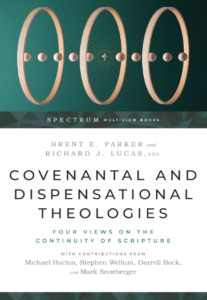
Author: Parker, Brent & Lucas, Richard
Genre: Theology - Dispensationalism, Theology - General
Tags: Doctrine / Theology
Series: Spectrum Multiview Book Series
Rick Shrader‘s Review:
This is another “Views” books which gives the reader four different views on a subject. This is also the second of such books I have reviewed this year. This volume covers the same topics as last month’s book but by different well-known authors.
Covenant Theology, by Michael S. Horton, the J. Gresham Machen Professor of Systematic Theology and Apologetics, Westminster Seminary. Horton is an obvious choice to write on covenant theology. His large volume on systematic theology, The Christian Faith (2011), has become a standard text for that point of view. Horton basically presents and explains the three “theological covenants” of covenant theology: the Covenant of Works, the Covenant of Grace, and the Covenant of Redemption. These are primarily defended from the Westminster Confession of Faith and other similar confessions (since they are not mentioned by name in the Bible). Horton goes on to link circumcision to infant baptism and Passover to communion in what he describes as a “Vista from the grand balcony of this covenantal house” (p. 60), though I think a view from the ground floor would have been more profitable.
Progressive Covenantalism, by Stephen J. Wellum, professor of Christian Theology, Southern Baptist Theological Seminary. Wellum has been the major voice for this more recent variation of covenant theology. He writes, “Progressive covenantalism argues that the Bible presents a plurality of covenants that progressively reveal our triune God’s one redemptive plan for his one people, which reach their fulfillment, telos, and terminus in Christ and the new covenant” (p. 75). There are two views among PC advocates that this section helps make clear. The first is Wellum’s “three horizons” of biblical interpretation: textual, epochal, and canonical. Textual is the immediate context; epochal is God’s unfolding plan; and canonical means considering a text with regards to what comes before and after. A second helpful explanation in this section is his extended discussion of typology. PC is heavy into type and antitype. “However, ultimately the types reach their antitypical fulfillment first in Christ and then his people” (p. 83).
Progressive Dispensationalism, by Darrell L. Bock, Senior Research professor of New Testament studies, Dallas Theological Seminary. Darrell Bock, along with Craig Blaising, also of Dallas Seminary, have become the leading voices in the PD movement. Bock describes his view by comparing it to traditional dispensationalism, especially each version’s view on Israel and the church. He writes, “The difference within dispensationalism is, whereas traditional dispensationalism kept the two tracks completely distinct, progressive dispensationalism brings them together so one people of God emerge among distinct structures of Israel, church, and then consummated kingdom” (p. 127-128). PD sees the kingdom existing today as a “already-not yet” kingdom (inaugurated eschatology). Among Bock’s many contributions to this view, one that clarified it was Bock’s view that in the millennial kingdom, the “one people of God” means also that even Israel will not have a more prominent place than the other nations. “Again, this is not Israel over the nations, but Israel with the nations” (p. 139).
Dispensationalism, by Mark Snoeberger, professor of systematic theology and apologetics, Detroit Baptist Theological Seminary. Since this traditional dispensational view is what I believe, I enjoyed this section the most. In fact, I thought it was one of the best defenses and explanations recently given. Among the topics covered, I thought Snoeberger’s description of literal interpretation as “originalist” was unique, in keeping with current understanding of constitutional issues. Also, his explanation of how the OT is used in the NT was very helpful, including his criticism of typological methods. But perhaps the best contribution was his explanation of how the biblical covenants and biblical dispensations fit and work together including a unique chart (p. 166). Snoeberger lists the “formal” covenants: Abrahamic, Mosaic, Davidic, New, and includes the Palestinian in some places. Other so-called covenants (such as Edenic, Protoevangelium, and Eternity) he labels as “arrangements” which contain no redemptive element and were not made with Israel specifically. The dispensations, then, are God’s way of administrating His plan for the earth. Snoeberger also emphasizes that God’s glory in the millennial kingdom will be the culmination and the doxological (rather than redemptive) center, or “mitte” in God’s purposes. “The rule of God” is “God’s primary plan for achieving his own glory” (p. 164).
